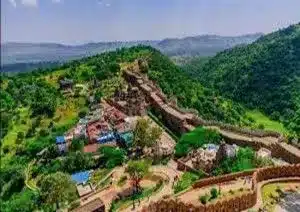About Kumbhalgarh Wildlife Sanctuary:
- Location: It is situated in the Rajsamand district of Rajasthan.
- Covering a total surface area of 578 sq km and stretching across the Aravalli ranges, it encircles parts of Udaipur, Rajsamand and Pali districts.
- Once the hunting grounds of royals, this area was declared a wildlife sanctuary in 1971.
- The wildlife sanctuary encompasses the historic Kumbhalgarh Fort and is also named after the fort.
- Rivers:
- River Banas also graces the sanctuary and is the primary source of water.
- The rainwater on the western slopes flows as small rivers such as Sukdi, Mithdi, Sumer and Kot, all of which are the tributaries of River Luni that ultimately merge into the Arabian Sea.
Background:
- The Union government and National Tiger Conservation Authority in 2023 gave in-principal approval for designating Kumbhalgarh-Todgarh Raoli sanctuaries as a tiger reserve.
- It is proposed to span around 1,397 square kilometres across Rajsamand, Udaipur, Pali, Ajmer and Sirohi districts of Rajasthan.
- Flora:
- Many types of flora are found here, mainly a variety of herbal flora like Dhok, Salar and Khair.
- Fauna:
- It provides a suitable habitat for endangered and rare wild animals, including four horned antelope, sambar, wild boar, nilgai, sloth bear, leopard and caracal.
About Todgarh Raoli Sanctuary
- It spans approximately 495 square kilometers across the districts of Ajmer, Pali and Rajsamand.
- It has been named after Colonel James Tod, a British officer who chronicled Rajasthan’s history.
- It was established in 1983.
- The sanctuary encompasses the ancient Raoli forest, home to numerous indigenous tribes.
- Flora: It is characterized by dry deciduous forests, with prominent species such as teak, bamboo, and dhok trees. The forest canopy is interspersed with flowering plants like kachnar (Bauhinia variegata), palash (Butea monosperma) and the vibrant flame of the forest, which add a splash of color to the greenery, especially during the blooming season.
- Fauna: It is a crucial habitat for several species, including the elusive leopard, sloth bear, and sambar deer. Birdwatchers can delight in the sight of over 200 bird species, including the grey junglefowl, Indian pitta and crested serpent eagle.
Q1. Which are the main tributaries of Banas River?
The Banas river rises near Pindwara village in Sirohi district of Rajasthan at an elevation of 372.5 m above mean sea level. The number of principal tributaries, which contribute significantly, is seven. Sipu is the only major tributary on the right bank. The other six tributaries namely Batria, Sukli, Sewaran, Suket, Balaram and Khari drain into the main channel from the left bank.
News: Improve habitat before designating Kumbhalgarh as tiger reserve: Expert panel
Last updated on December, 2025
→ Check out the latest UPSC Syllabus 2026 here.
→ Join Vajiram & Ravi’s Interview Guidance Programme for expert help to crack your final UPSC stage.
→ UPSC Mains Result 2025 is now out.
→ UPSC Notification 2026 is scheduled to be released on January 14, 2026.
→ UPSC Calendar 2026 is released on 15th May, 2025.
→ The UPSC Vacancy 2025 were released 1129, out of which 979 were for UPSC CSE and remaining 150 are for UPSC IFoS.
→ UPSC Prelims 2026 will be conducted on 24th May, 2026 & UPSC Mains 2026 will be conducted on 21st August 2026.
→ The UPSC Selection Process is of 3 stages-Prelims, Mains and Interview.
→ UPSC Result 2024 is released with latest UPSC Marksheet 2024. Check Now!
→ UPSC Prelims Result 2025 is out now for the CSE held on 25 May 2025.
→ UPSC Toppers List 2024 is released now. Shakti Dubey is UPSC AIR 1 2024 Topper.
→ UPSC Prelims Question Paper 2025 and Unofficial Prelims Answer Key 2025 are available now.
→ UPSC Mains Question Paper 2025 is out for Essay, GS 1, 2, 3 & GS 4.
→ UPSC Mains Indian Language Question Paper 2025 is now out.
→ UPSC Mains Optional Question Paper 2025 is now out.
→ Also check Best IAS Coaching in Delhi

















